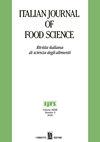The stability of phycocyanin extracted from Arthrospira platensis against osmotic, acid, and temperature stress conditions
IF 3.6
4区 农林科学
Q2 FOOD SCIENCE & TECHNOLOGY
引用次数: 0
Abstract
The main problem of using natural blue pigment of phycocyanin produced by Arthrospira platensis (spirulina) is its instability in the food matrix because of environmental stress. This study aimed to investigate the stability of phycocyanin under simulated conditions in food formulations against osmotic, acid, and temperature stress conditions. Thermal degradation constant (Dc) and half-life (t½) of phycocyanin extracted from Arthrospira platensis were analyzed using response surface methodology followed by a first-order kinetic reaction. The stability of phycocyanin was assessed under various temperature (50–98ºC), NaCl (0–2% w/w), and pH (4–7) values. Results showed that the stability of phycocyanin extracted from Arthrospira platensis is high at neutral pH and concentration of 1% (w/w) NaCl. The stability decreased with increase in temperature at ≥75°C. The highest stability of phycocyanin (the lowest Dc and the maximum t½ were 0.011 min-1 and 54.03 min, respectively) was achieved at 66.89°C, pH = 6.6, and NaCl of 0.40% w/w. According to processing conditions, content of phycocyanin required for a food matrix is successfully calculated by the response surface method. This research showed that phycocyanin is stable at thermal shock in a neutral pH medium and low content of NaCl (0.40% w/w).从板蓝根节肢动物中提取的藻蓝蛋白对渗透、酸和温度胁迫条件的稳定性
使用螺旋藻(Arthrospira platensis)产生的天然蓝色色素--藻蓝素的主要问题是,由于环境压力,它在食品基质中不稳定。本研究旨在研究在模拟条件下,藻蓝蛋白在食品配方中对渗透压、酸和温度应力条件的稳定性。研究采用响应面方法学,通过一阶动力学反应分析了从节肢动物中提取的植物花青素的热降解常数(Dc)和半衰期(t½)。在不同温度(50-98ºC)、NaCl(0-2% w/w)和 pH 值(4-7)条件下,评估了藻蓝蛋白的稳定性。结果表明,从节肢动物中提取的藻蓝蛋白在中性 pH 值和 1%(重量比)NaCl 浓度下稳定性较高。在温度≥75℃时,稳定性随温度升高而降低。在 66.89°C、pH = 6.6 和 NaCl 浓度为 0.40% w/w 时,藻蓝蛋白的稳定性最高(最低 Dc 和最大 t½ 分别为 0.011 min-1 和 54.03 min)。根据加工条件,响应面法成功地计算出了食品基质所需的植物花青素含量。该研究表明,在中性 pH 介质和低氯化钠含量(0.40% w/w)条件下,植物花青素在热冲击下是稳定的。
本文章由计算机程序翻译,如有差异,请以英文原文为准。
求助全文
约1分钟内获得全文
求助全文
来源期刊

Italian Journal of Food Science
工程技术-食品科技
CiteScore
4.20
自引率
0.00%
发文量
33
审稿时长
>36 weeks
期刊介绍:
"Italian Journal of Food Science" is an international journal publishing original, basic and applied papers, reviews, short communications, surveys and opinions on food science and technology with specific reference to the Mediterranean Region. Its expanded scope includes food production, food engineering, food management, food quality, shelf-life, consumer acceptance of foodstuffs, food safety and nutrition, energy and environmental aspects of food processing on the whole life cycle.
Reviews and surveys on specific topics relevant to the advance of the Mediterranean food industry are particularly welcome.
文献相关原料
| 公司名称 | 产品信息 | 采购帮参考价格 |
|---|
 求助内容:
求助内容: 应助结果提醒方式:
应助结果提醒方式:


